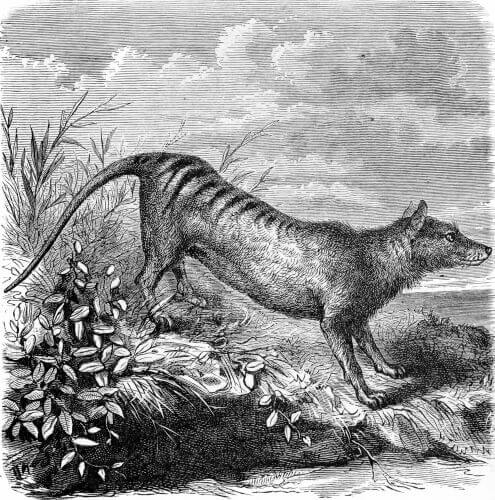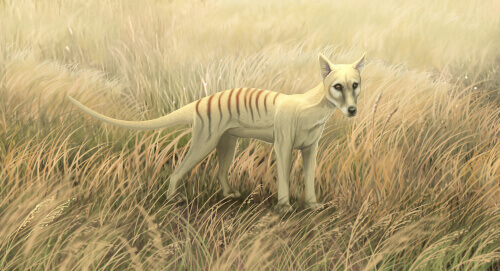Characteristics of the Tasmanian Tiger

The Tasmanian tiger, also known as marsupial wolf, thylacine, or Tasmanian wolf was a marsupial mammal that inhabited the earth until the 20th century.
This curious animal was native to Australia, Tasmania, and New Guinea, and was the last living member of the genus Thylacinus. The fossil records of this species date back to the Holocene period. However, its relatives appeared earlier, during the Miocene period.
The beginning of the extinction of the thylacine began in Australia but they were able to survive together with the Tasmanian devil, their closest living relative.
The Tasmanian tiger was a super predator just like the placental wolves. However, it’s a marsupial, and so it has no phylogenetic relationship with canids.
Thanks to convergent evolutionary processes, it has a similar appearance and adaptations as wolves. That is, the characteristics of both evolved independently, but, given their similar lifestyles and predation, they developed similar morphological adaptations between them.
Characteristics of the Tasmanian tiger
Morphology
Despite being an extinct animal, the Tasmanian tiger represents one of the few cases in which a morphological record of it could be made. They were present in modern society before their extinction.
- This animal has a rigid tail that’s similar to that of kangaroos and the tip in young specimens has a crest
- Adults ranged between 39 and 71 inches long, 24 inches high, and weighed between 44 and 66 pounds
- Their fur was short, thick, smooth, and yellowish-brown
- They had about 13 to 21 stripes distributed between the back, torso, and tail, more visible in young specimens
- They had rounded and erect ears of approximately 3 inches
- There was a certain sexual dimorphism as regards size, and, also, the females had a pouch with 4 breasts
- Their jaws were powerful with a large opening angle due to their predatory nature
- Finally, their hind legs had 4 toes, instead of 5, like on the front paws, which were retractable
The Tasmanian tiger is often compared to a hyena due to its posture and general behavior.

The behavior of the Tasmanian tiger
There’s not much data regarding the behavior of the Tasmanian tiger, researchers only got to watch them in captivity and during the day. This is sort of ironic as they were nocturnal animals. Therefore, the recorded data of the behavior in the wild is scarce and anecdotal and has always been extrapolated to the behavior of the Tasmanian devil.
This animal prowled in a radius of 25 to 50 miles in their natural environment, but it wasn’t territorial. They hunted during twilight and sought refuge in small caves or trunks of small trees in the forest or hills during the day.
The first observers of the Tasmanian tiger described this animal’s behavior as:
- Shy in the presence of humans although some specimens displayed more closeness; furthermore, Australian aborigines claimed to have seen some of them swim occasionally.
- They made a series of guttural barks when they were getting ready to hunt, probably to communicate with other members of the group. They also growled and hissed when threatened and researchers even observed a yawn which they interpreted as a threat.
The observers believed they mainly relied on their sight and hearing when hunting. This is because they didn’t think their olfactory lobes were particularly sophisticated.
Also, the breeding season lasted all year but mainly during the spring and summer. The young stayed in their mother’s pouch for up to 3 months after birth. They would stay in the cave while the mother hunted, but once they abandoned the pouch, then they were large enough to sort of fend for themselves.
Researchers studied their locomotive function during their observations of them in captivity. What they discovered is that the Tasmanian tiger was rather clumsy when they walked. Thus, they think these animals were incapable of running fast. However, they also noted that their bipedal jump is similar to that of a kangaroo.

Diet
The Tasmanian tiger was exclusively carnivorous. Their stomach had a large layer of muscle that they could stretch. Possibly, this was an adaptation to be able to accumulate large amounts of food for long periods of time when food was scarce.
Their main prey was kangaroos, wallabies, wombats, birds, and kangaroo rats.
Extinction
The Tasmanian tiger became extinct about 80 years ago. The last specimen died in captivity in 1936.
The hunting of this animal in the Australian antipodes contributed to its extinction. However, recent scientific studies showed that the Tasmanian tiger was doomed to extinction as reflected by its DNA data.
This may be shocking, but the genetic diversity of this animal showed a drastic decline pattern even before people began to hunt it. In the natural world, this decrease in long-term genetic variability translates into greater vulnerability to environmental changes. Eventually, this will lead to extinction.
Thanks for reading.
All cited sources were thoroughly reviewed by our team to ensure their quality, reliability, currency, and validity. The bibliography of this article was considered reliable and of academic or scientific accuracy.
- Berns, G. S., & Ashwell, K. W. (2017). Reconstruction of the cortical maps of the Tasmanian tiger and comparison to the Tasmanian devil. PLoS One, 12(1), e0168993.
- Feigin, C. Y., Newton, A. H., Doronina, L., Schmitz, J., Hipsley, C. A., Mitchell, K. J., … & Pask, A. J. (2018). Genome of the Tasmanian tiger provides insights into the evolution and demography of an extinct marsupial carnivore. Nature Ecology & Evolution, 2(1), 182-192.
